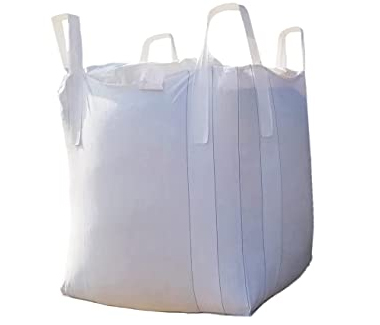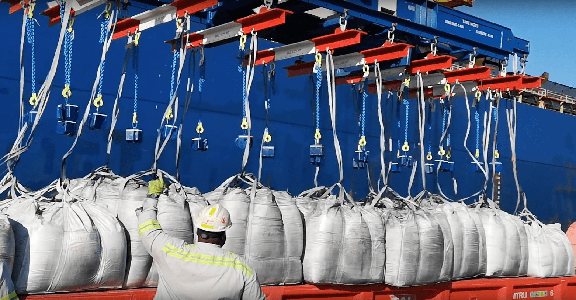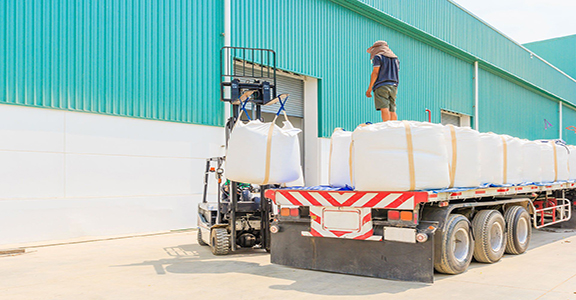Bulk Bags also known as big bags and ton bags. Generally, polypropylene or polyethylene is used as the main raw material, which is extruded into film, cut, drawn, and then woven, cut, and sewn. The use of this kind of packaging is not only conducive to improving the loading and unloading efficiency, but is especially suitable for the packaging of bulk powder and granular goods. advantage. Especially suitable for mechanized operation, it is an ideal choice for storage, packaging and transportation. It can be widely used in road, rail and sea transportation of bulk materials such as cement, fertilizer, salt, sugar, chemical raw materials, ores. Therefore, in recent years, countries around the world have widely used Bulk bags to transport powder and granular goods. The appearance and use of bulk bags is a qualitative revolution in the way of powder and granular goods shipment.

(Bulk Bags - Woven Polypropylene Tonbags in bulk S-353555)
First, hang the lifting ring of the container bag symmetrically on the beam of the filling machine, so that the bottom of the container bag is basically in contact with the ground, then open the loading port of the container bag, put it into the charging barrel and clamp it by the clamping device to avoid dust or particle leakage. Start the filling machine to put the raw materials into the bag from the charging port, and straighten the bag body before filling. After filling, close the charging port. If using a container bag with a discharge port, check whether the bottom is tied well before filling.
Hang the lifting ring of the container bag on the lifting device evenly. According to the type and loading weight of the container bag, forklifts, cranes, cranes, etc. can be selected. If a forklift is used to lift the container bag, the shovel plate should be adjusted to an appropriate position, and the container bag should be close to the forklift and not tilted forward. In order to ensure the balance of the center of gravity of the bag body during hoisting, be careful not to hang a single ring. Then, start the lifting device to slowly lift the container bag, and after reaching a certain height, evenly lay it on the train (or car) platform. If they do not need to be loaded and transported away immediately, they should be stacked neatly and uniformly at the workplace. During the hoisting and stacking process, they should not be squeezed, skewed, or collided with each other.
In principle, after the container bag is loaded, it should be loaded and left immediately, but if necessary, it cannot be transported immediately. In order to avoid material damage, the container bag should be stored in the warehouse, and the surrounding environment should be kept away from water, steam, humidity and High temperature sources, such as when stored outdoors, in addition to meeting the above environmental conditions, should also be covered with tarpaulins and avoid direct sunlight.
Lift the container bag with a forklift or crane, align it with the mouth of the trough or other container, open the tether at the bottom of the bag body, and the raw material can fall by itself to complete the unloading. For single-use container bags, a suitable tool can be used to puncture the bottom of the bag at a distance to discharge the material. During lifting and unloading operations, do not stand under the bulk bags.

Bulk bags have different uses in different industries. Below, we'll look at which industries use bulk bags. Some of the industries that use bulk bags include:
①Agriculture: All types of flour—wheat, corn, barley, etc.—are suitable for shipping in bulk bags, as well as many other grains and dry produce such as coffee beans and peanuts.
②Animal Feed: Livestock feed and pet food are also ideal for shipping in bulk bags. These dry bulk products ship well in bulk bags and can be stored in bags upon arrival at their destination. .
③Chemical Industry: Other products such as dry, non-reactive chemical powders and pharmaceuticals are also ideal for bulk shipping. Even dangerous goods can be transported safely if the company invests in the right bulk bags.
④Construction: In the construction industry, sand, gravel, cement, resin and other materials are easily lifted and transported using FIBC.
⑤Food Processing: Dry food products such as sugar, grains, seeds, coffee beans, and nuts are well suited for bulk bag shipping.
⑥Mining: In the mining industry, mining products such as coal, minerals and metal ores are also ideal for bulk bag transportation.

As a professional Bulk bags manufacturer, we provide you with professional flxeible intermediate container solutions. At the same time, we also provide Bulk bags manufacturers with polypropylene raw materials, polypropylene textile fabrics and other bulk bags related materials. Dema Import and Export will provide you with cost-effective Bulk bags and PP woven sacks with first-class quality and service. Welcome your inquiry.
